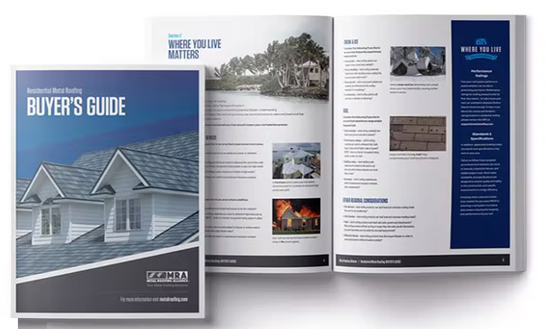Separating Fact From Fiction When It Comes To Severe Storm Season And Its Impact On Homes
From the Metal Roofing Alliance
Portland, OR — Homeowners take heed: The prime time for thunder, lightning and hailstorms is on the way, with two-thirds of lightning-related fires occurring between June and August. With that in mind, how do you separate fact from fiction when
it comes to protecting your home from one of Mother Nature’s most powerful forces? Take the following pop quiz.
Fact or Fiction: The type of roof on your home makes a difference on whether it might be struck by lightning.
Answer: Fiction. Lightning typically strikes the highest object, regardless of what material it is. According to the National Weather Service, height, pointy shapes and isolation are the dominant factors for where a lightning bolt will strike. The presence of metal
makes no difference. That’s why natural objects like trees and mountains (that are obviously not made of metal) frequently get struck.
The bottom line: Metal roofs are no more likely to draw or attract lightning than any other type of roof. In fact, metal is used frequently in the most lightning prone areas because it performs exceptionally well in severe winds, hail and rain that are
often experienced along with lightning storms.

For more information about top performing roofs that can add
long-lasting resiliency and help protect a home in extreme weather, get a
free copy of MRA’s Metal Roofing Buyer’s Guide by clicking on the image above.
Fact or Fiction: It’s rare that a home will get struck by lightning and if it does, the biggest danger is it catches on fire.
Answer: Fiction. The National Lightning Safety Institute estimates 1 out of every 200 homes will be struck by lightning per year. According to the CDC, a house is a safe place to be, so long as you avoid water, electronic equipment (including corded phones), TV cables, concrete, doors and windows.
Most commonly, lightning causes a power surge that damages electrical systems and appliances. That said, fire is a definite potential. Each year, the U.S. Fire Administration estimates17,400 fires are attributed to lightning. A properly grounded metal roof may work to help conduct energy from a lightning
strike over a broader area of the roof, reducing the amount of heat transferred to the building and reducing the potential damage due to fire. However, most fires are caused by lightning strikes outside the home when nearby trees, brush or other organic
material ignite. Quality metal roofs also work to protect against wayward sparks and carry Class 4 ignition protection – the highest level of protection available against wildfires.
Fact or Fiction: Roof damage from large hailstones is always visible, making it easy to spot needed repairs
Answer: Fiction. On typical asphalt roofs, hail can cause hairline cracks and displace shingles; damage that can be hard to detect. A homeowner may not realize their roof has been compromised until it’s too late and a leak is found, potentially
resulting in costly damage to a home’s interior as well.
Fact or Fiction: The underlayment selected is just as important as the roofing material when it comes to performance.
Answer: Fact. No matter what the roof type, quality underlayment is essential. Underlayment helps ensure a roof is watertight and protects against ignition in wildfire prone areas. Also important is a quality roof installation that ensures the
roofing system is resistant to damage caused by severe storms, hail, and, in the case of fire, burning embers.
Fact or Fiction: A roof with a Class 4 hail impact rating is the best a homeowner can get
Answer: Fact. Class 4 hail refers to a roof material test that measures a roofing product’s ability to withstand damage from hail impact. Specifically, this is the UL2218 Impact Rating test conducted by Underwriters Laboratories (UL), a not-for-profit organization that independently tests and certifies roofing products.
The UL2218 Impact Rating test is considered the national standard for measuring a roof’s ability to withstand hail damage. During the test, steel balls of various sizes are dropped on the roofing product from varying heights. Based on the results,
roofing products are certified as Class 1, Class 2, Class 3, or Class 4.
A Class 4 rating is the highest possible rating and indicates that the roof can withstand hail impact. Many quality metal roof systems achieve Class 4 hail ratings, making them a superior choice for regions that experience frequent lightning, hail, and
high winds.
About The Metal Roofing Alliance
 Representing metal roofing manufacturers in the United States and Canada, the Metal Roofing Alliance (MRA) was formed in 1998 as a
nonprofit organization to help educate consumers about the many benefits of metal roofs. The main objective of MRA is to increase awareness of the beauty, durability and money-saving advantages of quality metal roofs among homeowners, as well as to
provide support for metal roofing businesses and contractors. For more information, visit
metalroofing.com.
Representing metal roofing manufacturers in the United States and Canada, the Metal Roofing Alliance (MRA) was formed in 1998 as a
nonprofit organization to help educate consumers about the many benefits of metal roofs. The main objective of MRA is to increase awareness of the beauty, durability and money-saving advantages of quality metal roofs among homeowners, as well as to
provide support for metal roofing businesses and contractors. For more information, visit
metalroofing.com.




